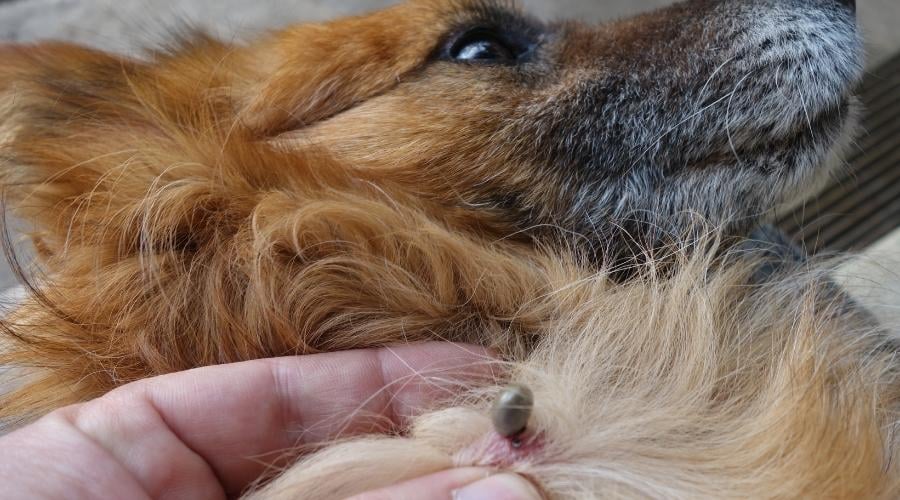When Your Dog Mistakes Play-Doh for A Treat: A Vet’s Chew-And-Tell
When you purchase through links on our site, we may earn a commission. Here’s how it works.
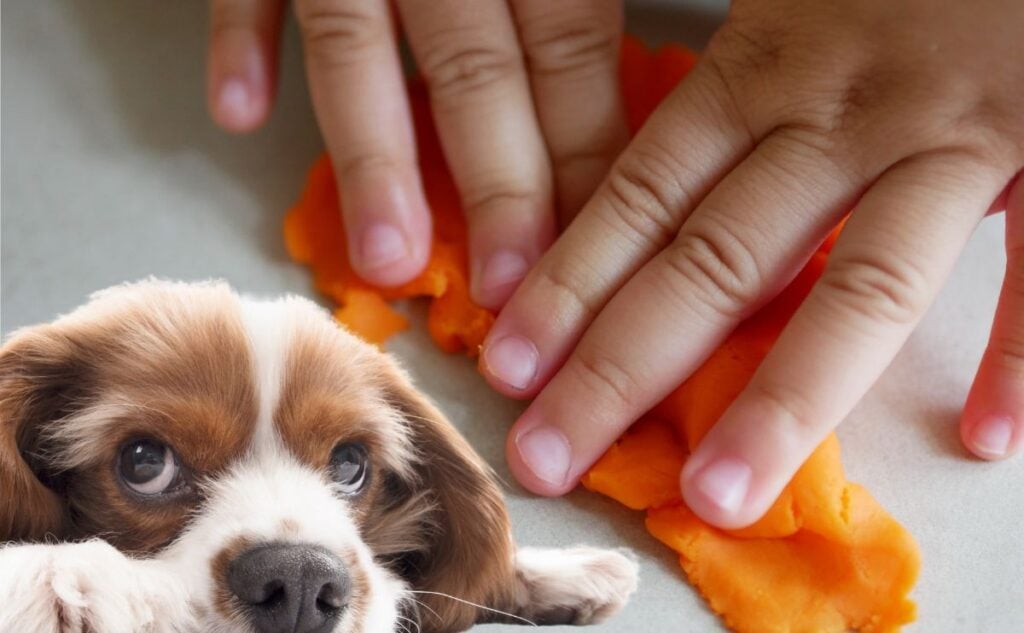
Your playful pup has just gobbled up a chunk of Play-Doh left behind by your child. Panic sets in as you wonder: could this colorful clay be harmful? Is Play-Doh toxic or harmful to dogs? Play-Doh has been a childhood staple since the 1950s. Kids love it because it’s bright, bouncy, and feels like magic in their little hands. Dogs? They love it because it smells like a weirdly delicious salty mystery. If your pup has a good sniffer, and they all do, they’ll lurk like a fuzzy little Play-Doh goblin when the container pops open.
Dogs experience the world with their mouths, so if there’s Play-Doh in reach, there’s a good chance it’s going in. So what happens when your dog mistakes Play-Doh for a Michelin-starred appetizer? As a vet, I’ve seen more than my fair share of dogs who thought Play-Doh was a five-star delicacy. Here’s what really happens when your pooch goes in for a bite of the arts and crafts buffet.
Unpacking Play-Doh: What’s Inside?

Play-Doh might feel like magic in your hands, but it’s actually made from a pretty simple mix of ingredients. The basic recipe includes water, salt, and flour. Commercial versions sometimes add fragrances, food coloring, preservatives, and even petroleum-based products to give it that perfect texture. They may also include antimicrobial agents, which makes sense when you consider how many sticky fingers (and maybe curious dog noses) end up poking around in the sticky stuff.
Many homemade recipes also call for cream of tartar, which helps preserve the dough and improve texture. If you’re wondering what cream of tartar is, it’s a by-product of grape fermentation. So technically, your homemade Play-Doh has something in common with wine. Just don’t let your dog near either one.
Whether you’re making pretend bones for your dog-obsessed toddler or trying to keep the pups from taste-testing your craft project, knowing what goes into Play-Doh is helpful. Homemade versions are usually non-toxic, but they contain a lot of salt, which can be dangerous if a dog eats too much. So, keep the dough fun going, but maybe stash it out of paw’s reach when playtime is over.
The Great Play-Doh Buffet: One Dog’s Journey to Rainbow Poop Glory
My sausage dog, Chips, has a talent for devouring literally anything she can get her paws on. Apparently, Play-Doh ranks high on her list of gourmet delicacies. I recently learned this the hard way when I made the rookie mistake of leaving my daughter’s favorite Play-Doh unattended on the coffee table.
I blinked, and there was Chips, happily munching away on a neon pink blob like it was the fanciest treat she’d ever had. Unfortunately, Play-Doh is definitely not dog-friendly, and the aftermath was, well, let’s just say the yard looked like a unicorn had passed through.
Because she hadn’t consumed a lot, I monitored her closely for the next few days. She showed no signs of illness or discomfort. Just proud of her rainbow poops. Chips is officially banned from all things Play-Doh going forward, and I’ll never leave it unattended again.
– Emma Braby, Rescue Dog Mom & Writer For Canine Journal
Danger Alert: Is Play-Doh a Threat to Your Dog?

As a veterinarian, I’ve had more than one panicked call from a pet parent whose dog just scarfed down a chunk of Play-Doh. It usually goes something like, “It was just a little bit… I think?” followed by, “Is this an emergency?” The short answer: maybe. The longer answer depends on how much your dog ate and what kind of Play-Doh it was. Due to the high salt content and potential for toxic cream of tartar, Play-Doh is not suitable for canine consumption.
Whether store-bought or homemade, Play-Doh contains a few ingredients that can raise red flags in the veterinary world. The smooth texture, bright colors, and salty scent may scream “fun” to kids, but they also scream “snack” to dogs. Unfortunately, Play-Doh is not meant for canine consumption, and in some cases, it can cause real problems.
Salt: The Sneaky Villain
Most types of Play-Doh contain a surprisingly high amount of salt. You probably don’t need to panic if your dog only eats a tiny nibble. However, if they gobble down a generous portion, that salt can start to throw their body chemistry out of balance.
Here’s the science behind it: Salt increases the concentration of sodium in the blood. Your dog’s body tries very hard to keep that level just right. Too much salt can lead to salt poisoning, which sounds dramatic because it is.
So, how much is “enough”? It depends on your dog’s size, overall health, and how much salt they actually ingested. When in doubt, call your vet.
Cream of Tartar: An Unexpected Risk
Cream of tartar, usually found in homemade play-doh, can also be toxic to dogs. Grapes, raisins, and similar products are all known to be toxic to dogs, and their by-products can be too. They all cause kidney failure in some, but not all, dogs. The exact reason for toxicity is still not fully known, and different dogs are affected very differently.
Research suggests the actual poison is a chemical called potassium bitartrate (which grapes contain varying levels of), and this chemical is also found in cream of tartar. We don’t know for certain yet that it is just the potassium tartrate that is toxic. To make matters worse, the exact toxic dose is not yet known for certain either. It’s generally simplest just to assume that any amount of tartrate is dangerous.
The frustrating part? Not all dogs react the same way. Some may eat a grape (or Play-Doh with cream of tartar) and be fine. Others may end up seriously ill. Since we don’t know exactly how much is too much or which dogs are more sensitive, it’s safest to assume any amount of cream of tartar is a no-go.
What About Other Ingredients?
Most commercial Play-Dohs are made with non-toxic ingredients, at least by human standards. But “non-toxic to children” doesn’t always mean “safe for dogs.” Artificial coloring, preservatives, or other mystery additives could also upset your dog’s stomach or cause other issues.
If your dog ate Play-Doh and you’re unsure about the brand or ingredients, or if they’re showing any signs of illness, it’s always best to call your veterinarian. We’d much rather reassure you than see your dog after things go sideways.
My Dog Ate Play-Doh – What Should I Do?
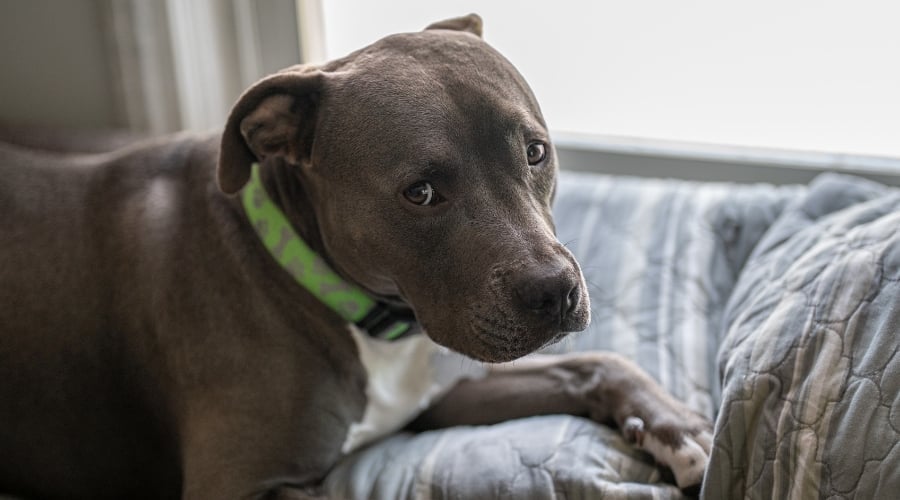
If your dog just got their paws or mouth on some Play-Doh, there are several steps you can take to make sure there’s minimal impact. Let’s take a look at a step-by-step outline of what you’ll likely need to do next.
Step 1: Separate your dog from the substance
If you can, get your pup to a separate safe space so you can clean up and remove the Play-Doh. Remove any from your dog’s mouth if it is safe to do so. This will stop the problem from getting any worse.
Step 2: Identify how much was recently consumed
It is worth working out how much has been eaten and saving any containers with ingredient lists on them for later inspection. If it is homemade, make a note of the recipe and ingredients. It is also worth noting the likely time that the Play-Doh was consumed.
Step 3: Contact your local veterinarian for advice
Based on the information you have gathered, your vet will assess potential risks with you and help you come up with a plan moving forward. Treatment will have a wide range of options. Your vet will determine the best treatment plan for your pup.
Step 4: Follow your veterinarian’s advice
They may recommend an examination at the clinic or advise you to monitor your canine companion closely at home. Make sure to follow your vet’s instructions, and contact your vet if you notice symptoms growing worse.
What Happens If My Dog Ate Play-Doh?
Many dogs that eat Play-Doh will show no ill effects at all and need no treatment or intervention. However, if a large amount of Play-Doh is consumed or if the Play-Doh contains a potentially toxic ingredient, then urgent professional veterinary help is required..
Risk Of Salt Poisoning

If a dog eats a large quantity of Play-Doh, this will introduce a significant amount of salt into their system. If this salt is excessive, relative to their body weight, it will be absorbed into the bloodstream and cause changes in the blood chemistry. In general, 2-3 grams of salt per kilo of body weight can cause poisoning.
The symptoms of salt poisoning include restlessness, vomiting, diarrhea, extreme thirst, lethargy, and shaking. These can progress to a wide variety of severe symptoms as the high salt causes the blood to thicken, organs to fail, and the brain to be damaged. Seizures and death can follow rapidly. This isn’t a scare tactic. It’s a real risk if your dog eats enough of the stuff.
Risk Of Kidney Failure

If a dog eats a product containing cream of tartar (or other grape-related products), it risks damage to the kidneys. Consumption of these toxins can send dogs rapidly into kidney failure. The dose is not accurately known for this type of poisoning, and dogs can all react differently. This means it’s best to assume any amount can be dangerous.
Kidney failure can cause excessive drinking and urination, as well as vomiting and lethargy. In extreme cases, excessive urination may rapidly become zero urination as the kidneys fail entirely and stop being able to produce urine at all. Again, seizures and death may quickly follow.
Vomiting, Diarrhea & Tummy Pain

If your dog has pre-existing health conditions, especially a sensitive tummy or a history of pancreatitis, then Play-Doh may be enough to upset these and make him sick. The symptoms would likely be vomiting, diarrhea, and tummy pain.
If you notice any of these symptoms, it’s essential to make sure your veterinarian is aware. This will help them understand the severity of the situation. It will also help them determine if there may be something else going on.
Treatment Options: Helping Your Dog Bounce Back
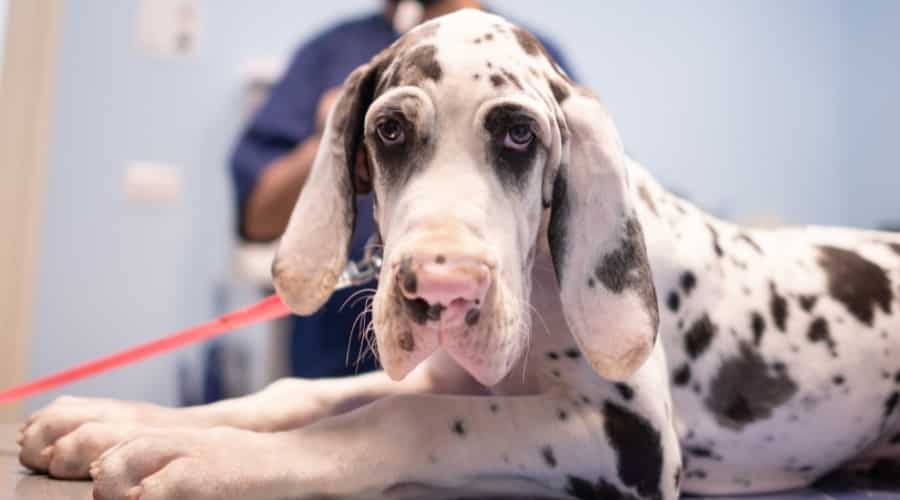
These potential issues are usually managed in a similar way. If your dog has only just swallowed the Play-Doh (within the last four hours), then it may be possible for him to receive a very safe, effective injection to cause intense vomiting and bring the Play-Doh back up before any potential poisons are absorbed.
- Vomiting should only be induced by a veterinarian in a safe environment – there are lots of home remedies, but these are usually risky and may make things worse. If the Play-Doh can be brought back up, this is the most straightforward resolution to the problem.
- If your dog has had time to absorb the poisons or is already showing symptoms of ill health, then your veterinarian will recommend more intensive treatment. This will provide your pup with the best chance of a speedy recovery. The veterinarian will perform an examination and usually recommend a blood test to look at the blood’s salt content and the kidneys’ current health.
- Based on the results, your pup will usually need intravenous fluids from a drip to dilute the poisons (especially salt) and encourage fluid movement through the kidneys to keep them functioning.
- Dogs may need this fluid therapy for 1-3 days or so, depending on how severely affected they are.
Other treatments may include anti-nausea meds, pain relief, or anything else your dog needs to feel better while their body recovers. With prompt care and a little time, most dogs bounce back just fine, though they may find themselves banned from the craft table permanently.
Will My Dog Be Okay After Eating Play-Doh?
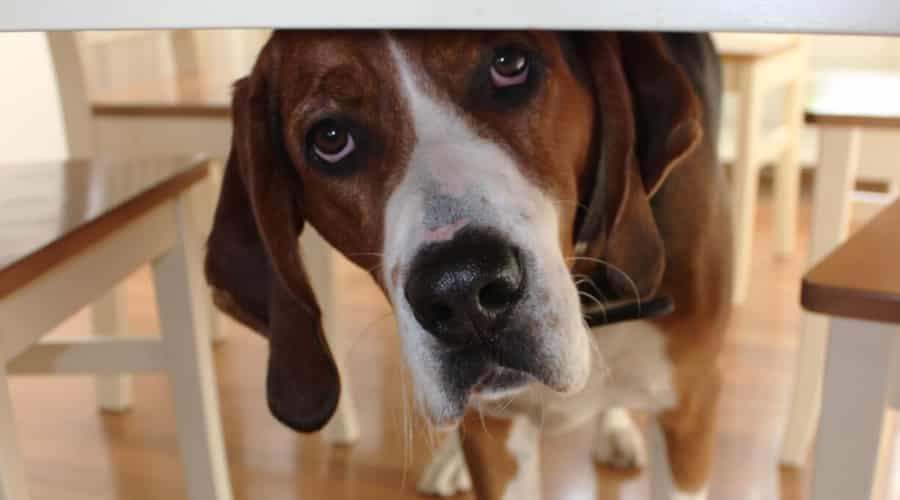
In most cases, if your dog only ate a small amount of Play-Doh, they’ll be just fine. A nibble here or there rarely leads to serious trouble, especially if it’s the store-bought kind. That said, the genuine concern comes when a dog manages to sneak a larger helping, especially if it’s homemade dough packed with salt or cream of tartar.
The sooner you speak to your veterinarian, the better the odds of a smooth recovery. Early action gives us the best chance to prevent toxins from being absorbed and manage symptoms before they worsen. Even if your dog is only showing mild signs like a bit of stomach upset or early salt-related symptoms, most bounce back quickly with some supportive care.
More serious cases are trickier. If a dog ingests enough salt or cream of tartar to affect their kidneys, the outcome can vary. Some dogs recover fully, while others may face long-term kidney issues, depending on how much was absorbed and their overall health going in.
Unfortunately, cream of tartar toxicity is unpredictable, much like grape and raisin poisoning. One dog might be fine, while another has a severe reaction to the same amount.
The most important takeaway? Don’t wait and see. Call your vet as soon as you know (or suspect) your dog ate Play-Doh. Quick action can make all the difference, and your vet will help guide you through the next steps to get your pup feeling better fast.
When to Call the Vet
Contact your veterinarian right away if:
- Your dog ate any homemade Play-Doh, especially if it contains cream of tartar
- You suspect your dog ate a large amount of commercial Play-Doh
- Your dog is showing any signs of illness, such as:
- Vomiting or diarrhea
- Excessive thirst or urination
- Lethargy or weakness
- Tremors or seizures
- Disorientation or unsteady walking
- You’re unsure how much was eaten or what kind it was
Even if your dog seems fine at first, it’s always safer to check in. Your vet can assess the risk, guide you on what to watch for, and take quick action if needed.
How to Keep Play-Doh Out of Fido’s Reach: 5 Prevention Tips
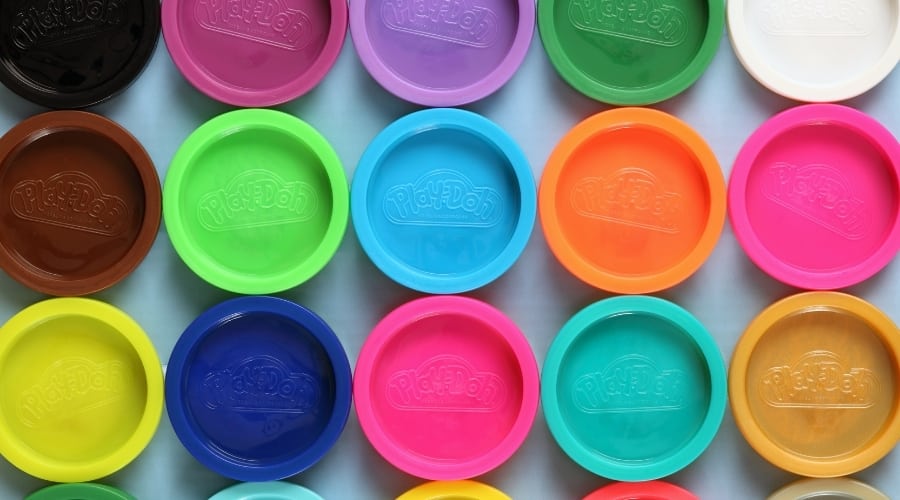
As much as we love our dogs, they can be like furry little vacuum cleaners, sucking up anything colorful, squishy, or vaguely edible. That’s why prevention is key to keeping Play-Doh out of their mouths and your vet bills under control.
- First things first: set some boundaries. If your kids have a designated play zone, try to keep your dog out of it, especially when arts and crafts are involved. A baby gate, a closed door, or even a firm “nope, not for you” can go a long way.
- Keeping play areas as tidy as possible is also a huge help. I know that’s easier said than done. But the fewer rainbow blobs lying around, the lower the odds of your dog sneaking a taste. Even a quick sweep after craft time can make a big difference.
- It’s also worth having a quick chat with your kids. Let them know that Play-Doh is not a treat for the dog, no matter how politely those puppy eyes might be begging. Some kids think sharing is caring, and while that’s a beautiful lesson, it doesn’t apply when it comes to feeding mystery dough to the family pet.
- When buying Play-Doh, check the label. While most commercial brands are labeled “non-toxic,” that usually means non-toxic to humans. Dogs have different sensitivities. Look for versions with reduced salt content or stick with smaller portions. Only opening one tub at a time can help limit the damage if your dog does manage to stage a snack attack.
- If you’re using homemade dough, consider safer alternatives that don’t include cream of tartar or other potentially harmful ingredients. Or better yet, store it safely out of reach and keep your pup busy with their dog-friendly enrichment toys while the kids are crafting.
In the end, prevention comes down to planning, training, and awareness. Your dog doesn’t know Play-Doh isn’t food, but with your help, they’ll never get the chance to find out.
Frequently Asked Questions: Play-Doh, Salt Dough, and Your Dog
Dogs are naturally curious and not exactly known for their excellent judgment regarding what they eat. If it smells interesting and fits in their mouth, chances are it’s going in. That’s why many pet parents ask, “My dog ate Play-Doh… now what?”
Here are answers to some of the most common questions I hear in the clinic when dough-related disasters unfold. If you don’t see yours, let us know in the comments.
Is Homemade Play-Doh Toxic to Dogs?
Homemade play-doh may seem harmless, but it often contains high levels of salt and sometimes cream of tartar, both of which can be dangerous for dogs. Salt can lead to dehydration or even salt poisoning in large amounts. Cream of tartar is especially concerning because it contains potassium bitartrate, a substance that may severely damage a dog’s kidneys. So yes, homemade Play-Doh can be toxic and should be kept well out of paw’s reach.
Is Salt Dough Dangerous for Dogs Too?
Yes, salt dough poses similar risks to Play-Doh. The biggest concern is the high salt content, which can disrupt your dog’s blood chemistry and affect vital organs like the brain, heart, and kidneys. Even a few bites can cause issues, especially in smaller dogs. Some salt doughs also contain added preservatives or fragrances that might be harmful if ingested.
Can Play-Doh Actually Kill My Dog?
As frightening as it sounds, Play-Doh can be deadly in certain situations. The danger usually comes from a large amount of salt or cream of tartar, especially if your dog is small or has preexisting health issues. These ingredients can cause serious complications such as kidney failure or salt toxicity. If your dog eats any amount of Play-Doh, it is always safest to contact your veterinarian right away for guidance.
Is Play-Doh Toxic to Puppies?
Yes, Play-Doh can be more dangerous for puppies than adult dogs. Puppies have smaller bodies and developing organs, which means they’re more vulnerable to toxins like salt and cream of tartar. Even a tiny amount of Play-Doh could throw off a puppy’s electrolyte balance or affect kidney function. Because their immune systems and metabolism are still maturing, it takes less to make them sick. If your puppy gets into Play-Doh, don’t wait and hope for the best. Call your veterinarian as soon as possible for advice tailored to their size and age.
What Happens If My Dog Licked Play-Doh but Didn’t Swallow It?
If your dog just gave the Play-Doh a lick or two and didn’t actually eat any, they’ll be fine. A slight lick might taste salty or weird, but it usually isn’t enough to cause serious problems. It’s still worth watching your dog for the next few hours. If they start drooling excessively, acting nauseous, or showing signs of stomach upset, give your vet a call just to be safe. It’s always better to check in early than to wait for symptoms to appear.
Ditch the Dough, Try These Instead!
While Play-Doh might look like gourmet cuisine to your dog, there are plenty of safer, more satisfying ways to keep them entertained. Dogs love to sniff, chew, and explore, so give them something that’s actually made for their curious nature. Try puzzle toys that make them work for treats, frozen Kongs filled with peanut butter or wet food, or interactive games like hide-and-seek with their favorite toy. Even a cardboard box filled with crumpled paper and hidden snacks can turn into a full-blown adventure.
Looking for low-effort enrichment? A snuffle mat or treat-dispensing ball can keep your dog busy while you get things done. If your dog loves chewing, provide durable toys like rubber bones or edible chews approved by your vet. The key is to give them something engaging that won’t land them in the ER.
Why Trust Canine Journal?
Dr. Joanna Woodnutt, MRCVS, is a UK-based veterinarian with a knack for making complex pet health topics easy to understand. She’s passionate about helping dog owners feel more confident and informed, whether it’s explaining how a medication works or when a quirky behavior might be a red flag. Jo believes that the more you understand your pet, the better you can care for them, and she’s here to make that knowledge accessible. She’s proud to be one of our featured veterinary experts at Canine Journal.



